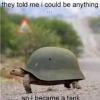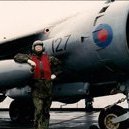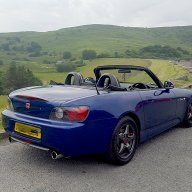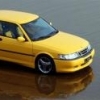Search the Community
Showing results for tags 'early'.
-
Hi all, here is my (mostly) completed 1/35 Sherman. Completely OOB except for a couple boxes and tamiya rope. I didn't worry about the figures all that much (you can tell from the photos) and the mudguards need some more touch-ups. I also need some more rope for the front stowage.But other than that, it's all done. Full WIP here: http://www.britmodeller.com/forums/index.php?/topic/234992193-tamiya-135-m4-sherman-early-version/page-1 Thanks for looking
-
Hi all, starting another WIP here Kit looks good for its age besides lots of seam joints showing, especially on the wheels and figures. Box and Sprue pics: Will be starting quite soon, as I am really keen to get started!
-
I tend to have a number of posts and was about to start another. Edgar is great with his answers so maybe we can all use one place for our Q and A, I just received Hayes owners manual and I noticed that the cutaway depicts both TR9 (Top) and side antenna. Interestingly none of the restored spits have any wires showing. I am doing and early MKIX so was wondering what the low down was on when to use both, none, only one type? Next (stupid questions - I am doing one of the desert polish MK IX's Eduards paint ref show no walk lines. I looked at a poor quality photo, to no avail. I know that the early Vb's were rushed out and repainted on arrival. I would have thought that by the time the MK IX's were dispatched they would have come in desert cammo with all the bells and whistle i.e. "no step" etc.
-
Supermarine Spitfire Mk.IXc Early Eduard Weekend 1:48 The Model Having released what is possibly the best Spitfire model so far in this scale, in Profipack and Royal Class editions, this kit is now available in a Weekend Edition. This kit includes all the styrene of the Profipack edition, but loses the pre-painted etched parts, masks and all but one of the marking options. What you do still get is a load of parts destined to go straight to the spares box. The build begins with the cockpit, and here some of the sidewall detail is moulded into the fuselage, with the rest being supplied as separate parts that fit to the lower sidewall inserts. The frame that holds the pilot's seat has recessed lightening holes that could be drilled out if you feel the need, and a sturdy mount for the seat and its two armoured plates behind it and in the head/shoulders area. The frame behind the pilot's seat is supplied as a top portion only, but little should be seen of that below the small rear glazed area anyway. Under the pilot's feet are the control linkages, as well as a further strengthening attachment point for the seat. The seat is built up from back and side parts, with the adjustment lever on the starboard side, and a flare rack in front, under the pilot's knees, which is then dropped into the cockpit with its armoured panel. The control column and linkage is built up from three parts, and then added in front of the seat along with a few additional sidewall details. The instrument panel is the forward bulkhead, and is supplied as either a single styrene part with raised instrument bezels on the surface, which you can paint or a flat plate on which the modeller can use the provided decal, The gun-sight and compass assemblies are then added to the panel, with the compass glued on the backside of the panel and protruding through the bulkhead opening between the pilot's knees, just like the real thing. Rudder pedals sit within the bulkhead, after which the other sidewall can be added, creating a neat assembly that is sandwiched between the fuselage halves after fitting the bulkhead to the engine-bay, the final frame to which the spinner attaches and the socket for the tail gear leg. If you're going to close the canopy, a couple of small segments of the sills are removed, as they won't be seen under the canopy, and would baulk its fitment if left behind. At this point, the leading edges of the wing root fairings are also attached. As is standard with the Spitfire wings in this scale (and most others), the lower wing is a single full-span part, and in this case, there is a stub spar that crosses the midline with around 3cm on each side providing a little strength to the wings, and forming part of the front wall of the landing gear wells. The upper wing section has been moulded with a thinner skin within the wheel well to give a more realistic depth, and also has details of the ribbing moulded into its surface. The balance of the wheel bay walls are constructed from short sections, which allowed Eduard to put some wall detail on them where appropriate, but take care getting alignment and orientation correct before committing to glue. Once the upper wings and separate wing tips are attached, the fuselage can be dropped into the gap and secured in place. The top cowling is a separate assembly, made up from two halves, and you have a choice which depends on which markings you intend to use. The exhausts that are fitted to each side of the cowling are slide-moulded to have a hollow exit, although the edges are a little thick when compared to the resin replacements. The exhausts fit into a pair of backing parts that give an impression of the engine within the cowlings, which must be almost unique on a stock kit at this scale, but it means that they have to be inserted before the top cowling is added, so must be painted and masked beforehand. The elevators are separate from the tail plane, and they are supplied as a single part with some impressive fabric and rib-tape texture on the surface. They must be installed before the rudder, and are locked in place by a pair of small parts that should allow then to remain mobile if you are careful with the glue. Ailerons are also separate, and these are of the metal type, so devoid of any fabric detail, as is correct. They can be posed at any sensible angle, and have small tabs at the hinge-points to improve the strength of their join. Underneath, the two piece chin for the engine cowling is added, with the chin intake built in, and the radiator housings are built up from individual sides, with the radiators themselves having very nice detailed mesh surfaces that should look good once painted carefully. The rear radiator flaps can be posed open or closed by substituting one jack-part for another, using the same panel, with the correct angles shown in a pair of scrap diagrams. Because of the almost scale depth of the wheel wells, the landing gear is built up the same way whether you are choosing to model it up or down. The only difference is that a small portion of the dished leg cover is removed so that they can fit within the bay recess. The tyres are provided in halves, with separate inner and outer hubs. If posing them down, the gear legs sit in a pair of keyed holes that ensure the angle and orientation are correct, but a pair of scrap diagrams provide clarification if you are unsure. The tail wheel is a single part that fits into the two-part yoke that terminates in a long shaft to plug into the socket within the fuselage that was installed earlier. The Spitfire IX had a four-blade prop, and this is one of the last assemblies, consisting of single part for the blades, around which the front and rear plate of the spinner are clamped. This then fits into a small hole at the front of the cowling, and will need to be glued in place unless you do a little scratch-building. The cannons in the leading edge of the wing are installed to the inner stations, while the outer ports are faired over with a pair of hemispherical bumps. The canopy gives you the option of a two-part closed assembly, which has the sliding and rear portions moulded together, or a three-part open assembly to display your hard work in the cockpit. The windscreen is fitted with a circular rear-view mirror on the very top of the roll-over loop, and the sliding portion has a small PE grab-handle/latch added to the front, which is a nice addition. and you use different parts for open and closed canopies. Lastly the aerial mast if attached to the fuselage via an insert followed by a small clear teardrop shaped bubble just aft of the mast and only used with certain marked aircraft. Decals The main decal sheet provides markings for just one aircraft, the decals for which are printed in-house by Eduard and are in good register, are sharp, and appear suitably opaque. They appear more matt than the Profipack decals. The decal used for the instrument panel then these too are very well printed and look quite realistic. No stencils are included in this edition. The markings are for Spitfire Mk.IXc, EN354, flown by 1st Lt Leonard V. Helton, of the 52nd FG, 4th FS, La Sebala Airfield, Tunisia, June 1943, in a similar scheme as EN315 above in Mid Stone, Dark Earth and Azure Blue colour scheme with a red spinner. Conclusion These Spitfires from Eduard are superb and no matter if you go for the Profipack or this Weekend edition the modeller is in for a treat. This edition is, in my opinion, really good value for what you get, loads of build enjoyment and a great looking Spitfire at the end. Highly recommended. Review sample courtesy of
-
Supermarine Spitfire Mk.IXc Early Eduard Profipack 1:48 Normally I would try and research the history of an aircraft type and give a short prologue to a review, but the Spitfire is probably one the best known aircraft ever I couldn’t really do it justice. Suffice it to say that the MkIX is pretty much regarded as the best of the breed. The Model Having had such acclaim from the release of the late version of the Mk.IXc, Eduard have followed it up with this release of the early version. Now having compared the sprues of both the late and early versions I honestly can’t see any difference in parts. From research it may depend on the size of the cannon blisters, but there are options for both wide and narrow in this kit. There also appears to be a slight difference in the style of the horizontal tailplanes and rudder. This is something for the Spitfire aficionados to ponder over. The kit itself is arguably the best Spitfire IX kit released to date. The mouldings are superb, the detail sublime and from what I’ve read on the forums, the fit is something rather special. What you do get in this kit is a load of parts destined to go straight to the spares box if the sprue diagrams are anything to go by. Being a Profipack the modeller also gets a small sheet of pre-painted etch and a sheet of paint masks. The build begins with the cockpit, and here some of the sidewall detail is moulded into the fuselage, with the rest being supplied as separate parts that fit to the lower sidewall inserts. The frame that holds the pilot's seat has recessed lightening holes that could be drilled out if you feel the need, and a sturdy mount for the seat and its two armoured plates behind it and in the head/shoulders area. The frame behind the pilot's seat is supplied as a top portion only, but little should be seen of that below the small rear glazed area anyway. Under the pilot's feet are the control linkages, as well as a further strengthening attachment point for the seat. The seat is built up from back and side parts, with the adjustment lever on the starboard side, and a flare rack in front, under the pilot's knees, which is then dropped into the cockpit with its PE armour panel, and the pre-painted seatbelts from the etched fret can be draped over the seat in a realistic way. The control column and linkage is built up from three styrene parts and one PE part, and then added in front of the seat along with a few additional sidewall details. The instrument panel is the forward bulkhead, and is supplied as either a single styrene part with raised instrument bezels on the surface, which you can paint or decal, or the more sophisticated lamination of three pre-painted layers to create a highly detailed panel with instrument dials that is glued to a styrene back-plate for strength. The gun-sight and compass assemblies are then added to the panel, with the compass glued on the backside of the panel and protruding through the bulkhead opening between the pilot's knees, just like the real thing. Rudder pedals sit within the bulkhead, after which the other sidewall can be added, creating a neat assembly that is sandwiched between the fuselage halves after fitting the bulkhead to the engine-bay, the final frame to which the spinner attaches and he socket for the tail gear leg. If you're going to close the canopy, a couple of small segments of the sills are removed, as they won't be seen under the canopy, and would baulk its fitment if left behind. At this point, the leading edges of the wing root fairings are also attached. As is standard with the Spitfire wings in this scale (and most others), the lower wing is a single full-span part, and in this case, there is a stub spar that crosses the midline with around 3cm on each side providing a little strength to the wings, and forming part of the front wall of the landing gear wells. The upper wing section has been moulded with a thinner skin within the wheel well to give a more realistic depth, and also has details of the ribbing moulded into its surface. The balance of the wheel bay walls are constructed from short sections, which allowed Eduard to put some wall detail on them where appropriate, but take care getting alignment and orientation correct before committing to glue. Once the upper wings and separate wing tips are attached, the fuselage can be dropped into the gap and secured in place. The top cowling is a separate assembly, made up from two halves, and you have a choice which depends on which markings you intend to use. The exhausts that are fitted to each side of the cowling are slide-moulded to have a hollow exit, although the edges are a little thick when compared to the resin replacements. The exhausts fit into a pair of backing parts that give an impression of the engine within the cowlings, which must be almost unique on a stock kit at this scale, but it means that they have to be inserted before the top cowling is added, so must be painted and masked beforehand. The elevators are separate from the tail plane, and they are supplied as a single part with some impressive fabric and rib-tape texture on the surface. They must be installed before the rudder, and are locked in place by a pair of small parts that should allow then to remain mobile if you are careful with the glue. Ailerons are also separate, and these are of the metaltype, so devoid of any fabric detail, as is correct. They can be posed at any sensible angle, and have small tabs at the hinge-points to improve the strength of their join. Underneath, the two piece chin for the engine cowling is added, with the chin intake built in, and the radiator housings are built up from individual sides, with the radiators themselves having very nice detailed mesh surfaces that should look good once painted carefully. The rear radiator flaps can be posed open or closed by substituting one jack-part for another, using the same panel, with the correct angles shown in a pair of scrap diagrams. Because of the almost scale depth of the wheel wells, the landing gear is built up the same way whether you are choosing to model it up or down. The only difference is that a small portion of the dished leg cover is removed so that they can fit within the bay recess. The tyres are provided in halves, with separate front and rear hubs, with a flat PE hub-cap installed on only one of the marking options. If posing them down, the gear legs sit in a pair of keyed holes that ensure the angle and orientation are correct, but a pair of scrap diagrams provide clarification if you are unsure. The tail wheel is a single part that fits into the two-part yoke that terminates in a long shaft to plug into the socket within the fuselage that was installed earlier. The Spitfire IX had a four-blade prop, and this is one of the last assemblies, consisting of single part for the blades, around which the front and rear plate of the spinner are clamped. This then fits into a small hole at the front of the cowling, and will need to be glued in place unless you do a little scratch-building. The cannons in the leading edge of the wing are installed to the inner stations, while the outer ports are faired over with a pair of hemispherical bumps. The canopy gives you the option of a two-part closed assembly, which has the sliding and rear portions moulded together, or a three-part open assembly to display your hard work in the cockpit. The windscreen is fitted with a circular rear-view mirror on the very top of the roll-over loop, and the sliding portion has a small PE grab-handle/latch added to the front, which is a nice addition. The side door is detailed with locking mechanism that is also made from PE, and you use different parts for open and closed canopies. Lastly the aerial mast if attached to the fuselage via an insert followed by a small clear teardrop shaped bubble just aft of the mast and only used with certain marked aircraft. Decals The main decal sheet provides markings for five different aircraft, the decals for which are printed in-house by Eduard and are in good register, are sharp, slightly glossy and appear suitably opaque. If you want to use the decals for the instrument panel then these too are very well printed and look quite realistic. The second sheet provides a full set of stencils for one aircraft and is equally well printed. The markings provided are for the following aircraft:- Spitfire Mk.IXc, EN315, flown by Stanislav Skalski, of the Polish Combat Team, Northern Africa, Spring 1943 and the subject of the box art in Mid Stone, Dark Earth and Azure Blue colour scheme with a red spinner. Spitfire Mk.IXc, EN133, of No.611 Squadron, Biggin Hill, Early 1943, in Standard Dark Green, Ocean Grey, with Medium Sea Grey undersides, Sky fuselage band and spinner. Spitfire Mk.IXc, BS392, flown by S/Ldr Bernard Duperier, CO of No.340 Squadron, Biggin Hill, Autumn 1942 in the same scheme as EN133. Spitfire Mk.IXc, EN354, flown by 1st Lt Leonard V. Helton, of the 52nd FG, 4th FS, La Sebala Airfield, Tunisia, June 1943, in a similar scheme as EN315 above. Spitfire Mk.IXc, EN568, flown by W/Cdr Alan C. Deere, CO of Biggin Hill Wing, Biggin Hill, June 1943 in the same scheme as EN133 and BS392. Conclusion The Eduard Spitfires have really raised the bar when it comes to detail, buildability and from what I’ve read accuracy. When you’ve invested so much time and effort to get something right it’s worth getting as much out of a mould as possible and this is what Eduard are good at. This release is a lovely example of this prudence, which at the same time gives the modeller more choice of kits to build. Highly recommended. Review sample courtesy of
-
Saw this build over on ARC and thought I'd share it. I've just got this kit, but somehow I don't think mine will turn out anything like this good! http://www.arcforums.com/forums/air/index.php?showtopic=274515&pid=2604576&st=0entry2604576 Andrew
-
Hawker Hurricane Mk.I (Early) Airfix 1:72 If one was to asked to give the name of a British fighter that took part in the Battle of Britain, the Spitfire would undoubtedly be the most common answer. However, the aircraft that provided the backbone of the defence in that infamous battle was the Hawker Hurricane. Designed in 1935, it was quite a step forwards to the existing front line RAF fighters of that era, key features being a fully enclosed cockpit, retractable undercarriage, 8 guns, powerful V12 engine and most notably, a single cantilever wing as opposed to a biplane configuration. Despite its revolutionary look though, the design and manufacturing techniques were old school, a steel frame with fabric skinning so in reality, it was very much a progressive rather than evolutionary design. This however was to provide useful in manufacturing and in the face of battle. The Hurricane was easy to produce, repair and maintain. This is in comparison to the birth of the Spitfire which used completely new manufacturing techniques which whilst offering performance, hindered early production. Early Hurricane Mk.I’s went through a series of design enhancements. Initial aircraft had fabric wings which limited the dive speed whilst the spin characteristics were a concern for test pilots. This was remedied by the addition of a strake below the rudder that became a key characteristic of the Hurricane. The fabric wings were also changed by 1940 for new metal skinned ones which increased the dive speed by some 80mph. Other notable improvements on the Mk.I were the addition of 70lb of armour plate for the pilot, self sealing fuel tanks and a 3 blade constant speed propeller. The availability of 100 octane fuel early in 1940 gave the Merlin an additional 30% boost power available compared to the power available on 87 Octane which was a significant when one needed to open the taps as wide as they would go!. With aircraft entering service in 1938 with the RAF and a few exports, the first blood was achieved on 21st October 1939 when a squadron of Heinkel He115’s were bounced by 46 Sqn looking for ships in the North Sea. The engagement resulted in 4 aircraft downed with more being claimed by 72 Sqn Spitfires. France was to prove more challenging for the Hurricanes as opposition was encountered by the more lethal BF109E’s. What became the Battle of France was to prove a bloody battle as a result of what the Luftwaffe were able to put up. With the German forces pushing forwards, the RAF and ground forces were forced to retreat to UK soil which paved the way for the Battle of Britain where the Hurricane achieved its legendary status alongside the Spitfire. Of the 2700 victories claimed during this battle by the RAF, nearly 1600 ware at the guns of the hurricane. Whilst the Hurricane soon became outdated a front line day fighter in Europe, it went on to see considerable success in other campaigns throughout the war. With the addition of bombs and cannon, it became an effective ground attack aircraft. It has its history firmly rooted in the battles of the Mediterranean, Russia and the Pacific, not to mention early night fighting over Europe where many aces earned their status. The kit The ‘rag’ skinned Hurricane is something of a neglected chapter in scale modelling in any scale. Whilst there are some kits / conversions out there, this is a most welcome addition to the 1/72 Hurricane family. Given the quality of recent Airfix releases coupled with the competitive pricing and wide availability, I’ve do doubt this will become a classic. The kit comes packed in the stunning new red top opening box with a beautiful digital image of 111 Sqn Hurricanes. With no less than 5 grey sprues, a clear one, decal sheet, two colour instructions and a colour painting guide, this is great value for money. First impressions are very good. Some of the newer releases from Airfix have been criticised for excessive depth of panel lines. Whilst these are not as refined as perhaps a Hasegawa kit, they certainly aren’t over the top. Moulding quality is excellent with virtually no flash or sink marks present. The surface detailing on the fuselage and wings is beautifully done with realistic looking fabric areas. Shape wise, it looks very good too. The wing has the slight kink noticeable on the inner section which I believe to be 3.5 degrees. Whilst I don’t have any 1/72 drawings available, proportions on the fuselage look good too, the curves, lumps and bumps all look good. Construction starts with the wings. A detailed main gear bay is first constructed before joining the top and bottom wings up, a straight forwards affair. The cockpit is then built and assembled into one of the fuselage halves with the rudder pedals and column being fitted to the wing centre section. Two rear bulkheads are supplied in the kit, one armoured, the other not. The instructions show only the non-armoured unit being used, however if you are going to use aftermarket decals, you may want to research your aircraft before selecting the correct one. Detail for the cockpit is only provided in decal form which for some will be well received. I would have preferred some surface detail, so you may want to use an aftermarket etch set if this is an issue to you. With the fuselage quickly assembled, two rear lower fuselages are supplied. The first is the early one without a strake, the second having the more typical and charismatic spin recovery strake. As the base of the rudder is different for each, two rudders are also supplied. Again, check your references before being rushing in with the glue! If one is to be critical on the fuselage, the fabric effect on the access panels below the cockpit fade out on the panel edges much the same as the criticised Hasegawa 1/48 kit, but the effect is subtle and less noticeable in this scale so it doesn’t bother me personally. Following a recent thread on Britmodeller, there has been some discussion about the two ‘bumps in the nose immediately behind the propeller at the 4 & 8 o’clock positions. It appears that very early variants didn’t have these. If this is the case on your aircraft, they can simply be sanded off if this detail is important to you. The rudder and tailplanes have the same quality of moulding as the main fabric areas. I’m particularly impressed with the elevator moulding. The Carburettor intake under the nose is a good example of how Airfix have moved on. The intake is recessed giving good scale representation, not simply a blob of plastic as you would get on 20th century kits leaving you to drill the intake out. Two options are provided for gear position. If you prefer to have your gear raised, the parts are superbly produced with wheels & doors moulded as one. This not only looks effective, but keeps it simple for novice builders. If you want to have the gear lowered, separate legs and doors are provided with accurately shaped inner door profiles and two part legs for each side. A noticeable error is the 4 spoke wheels. Typically, the early Hurricanes had 5 spoke wheels so correcting this will need aftermarket wheels. The radiator is another key feature on the hurricane and this is well represented. Both front and rear radiator faces are provided and nicely detailed and the variable flap is moulded in a slightly open position with a very thin edge as not to look toy like. As mentioned previously, both a two speed Watts fixed pitch prop and a 3 blade DH constant speed unit are provided giving more options as to the time period of your build. There are supported by the early slotted and subsequent triple ejector type exhausts. As I suspect that these evolutions happened across various time periods, using reference material for any specific aircraft will be critical if you desire an accurate build. A pleasing feature is the inclusion of a separate canopy enabling you to have it in the open position. This is quite thin and free from distortion. Two windscreens are provided, one of which has an armoured panel protruding out. Other minor features to be aware of in determining your build is things like the venture on the side of the cockpit. At some point, these were phased out with the introduction of a vacuum pump to provide vacuum for the instruments. For more references to detailing the hurricane accurately, please see: http://www.britmodeller.com/forums/index.php?/topic/234949886-airfix-hurricane-mk-1/page-1 http://www.britmodeller.com/forums/index.php?/topic/234950986-early-hurricane-mki-details-and-a-challenge-or-two/ Decals The decals look very nice. Very sharp print quality with a matt finish and excellent register are evident. With many options being available, I suspect that we’ll see a great many more options becoming available via the aftermarket manufacturers. Scheme 1 – RAF Dark Earth / Dark Green over Black port / White starboard and Aluminium Centre L1584 of 111 Sqn RAF Northolt in pre-war livery Scheme 2 – BAF Dark Earth / Dark Green over Aluminium 2/I/2AE Sqn (Chardon) of Belgian Air Force, Scaffen Air Base, 1940 Conclusion Although there's an obvious error in the kit, notably the 4 spoke wheels, and a decision not to include surface detail to represent cockpit instrumentation, this kit is a welcome addition to the Hurricane range now being offered by mainstream manufacturers in 1/72. The quality of the moulding and shape accuracy is reflective of the recent progress Airfix have made and as such offers great value for money. Both experienced and Novice builders alike will enjoy building this kit and I've no doubt that it will become a classic. Thanks to the Britmodeller contributors in the recent threads surrounding this kit who have offered the insight contained in this review regarding some of the detail changes that occurred during the early Mk.I development. Review sample courtesy of
-
Hi all Can anyone steer me towards a few more pics of Saab Gripens in the initial early scheme like this A Google search didn't bring up many. I'm not after many, just a few to guide me through the painting process, the Airfix instructions are not the best Cheers Chris
-
HI,As im building the atlas mercury manned rides,i thought i might have a go at some of the atlas variants,as they all basically used the same collapsible,thin skinned tanks,btw....whats Atlas brought into nearly every household,in the world,........yes WD-40,made to stop the shiny stainless tanks corroding,in salt air,whilst they waited to annihalate the world?.....youve got to have a shiny,finger of death?...sorry just thought id throw that one in.... The early atlas sm-65 only had 2 engines,the sustainer engine,the middle one was,nt needed,so i will have to remove that?,anyway thought id have a go at the nosecone,the only bit apart from the engine,which is different from any other Atlas....visually?first off look up references,photos,peter always rockets of the world,the bible? The nose cone has a straight adaptor from the tank to warhead,then a couple of steps to intergrate the warhead,looked easy,? right what can i use? thats the common base, leftover upper stage from a mach 2 thor missile, only need the interstage junction.... on top of the atlas shoulder... sorting a couple of increments with the angles right, found that the tops of the shuttle srb,s was a match for the angle,if cut in the right place? was going to use a missile as the warhead,but it was wrong diam? so,found that martins models,resin thrusters off a saturn kit,in a box,havnt got round to building yet,wayhay....great fit,had to round off the warhead though. the bits,also a section off a upper stage saturn ib. so needs some milliput on the joints yet,and some ribbing strips,around the cone,and a little bit of sanding..... but to me thats a not bad build? alongside the score variant,more of that later? cheers off too sand /paint Don
-
- resin
- 1/48.atlas variant
-
(and 1 more)
Tagged with:









